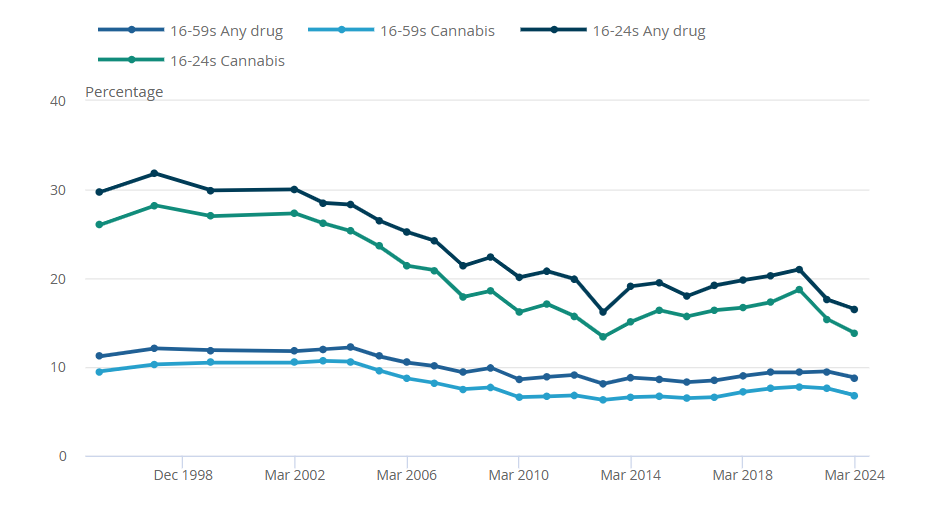Latest Drug Use Trends and Data: Key Highlights for Employers
The Office for National Statistics has released its latest report on drug misuse in England and Wales, offering a detailed look at how drug use is evolving across age groups and substance types. This article summarizes the key findings into digestible sections, helping employers, policymakers, and health professionals quickly understand the most important trends.
Overall Drug Use: A Slight Decline
- 8.8% of adults aged 16 to 59 reported using drugs in the past year — down from 9.5% the previous year.
- This equates to approximately 2.9 million people.
- The decline suggests a modest shift in behavior, though usage remains higher than a decade ago.
Most Commonly Used Drugs
- Cannabis remains the most used drug, with 6.8% of adults reporting use (down from 7.6%).
- Class A drugs (e.g., cocaine, ecstasy) held steady at 3.0%.
- Magic mushroom use increased from 0.8% to 1.1%, indicating a rise in psychedelic experimentation.
- Nitrous oxide and crack cocaine use declined.
Age Group Breakdown
- 16 to 24-year-olds reported the highest usage: 16.5% used drugs in the past year.
- This age group also showed higher rates of frequent drug use (more than once a month).
- Older age groups showed lower and more stable usage patterns.
Frequency of Use
- Frequent drug use dropped to 1.8% of adults, down from 2.3%.
- This suggests fewer people are using drugs regularly, though occasional use remains common.
Emerging Trends to Watch
- The rise in psychedelic drug use (e.g., magic mushrooms) may reflect shifting cultural attitudes.
- Declines in nitrous oxide and crack cocaine use could be linked to policy changes or availability.
- Younger users continue to drive experimentation and higher usage rates.
Making Sense of the Trends: Why It Matters Now
The latest Office for National Statistics report reveals a nuanced picture: while overall drug use among adults aged 16 to 59 remained steady at 8.8% (around 2.9 million people), cannabis use declined slightly, and psychedelic substances like magic mushrooms saw a modest rise. Frequent drug use dropped to 1.8%, suggesting fewer habitual users, yet younger adults (16 to 24) continue to report the highest usage rates at 16.5%. These figures point to a generational shift in drug experimentation and highlight the importance of monitoring emerging trends like psychedelics, even as traditional substances like nitrous oxide and crack cocaine decline.
For employers, these evolving patterns underscore the need for adaptable, real-time drug screening solutions. Intelligent Fingerprinting works to support organisations by providing discreet, non-invasive, and ethical testing that helps maintain a safe and healthy workplace.
To build on this, it’s worth understanding how to recognise the early signs of drug misuse among employees. This article on spotting substance abuse in the workplace offers practical guidance that complements the latest data — a valuable next read for any employer focused on safety and wellbeing.
Read: How to Spot Substance Abuse in the Workplace











